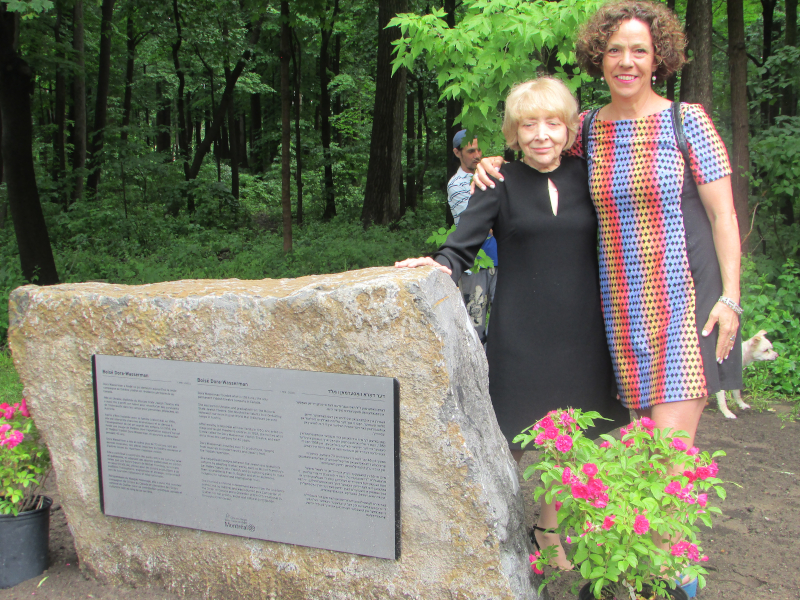The boulder is a fitting memorial to the determination of Dora Wasserman, but it should not be interpreted as a monument to the Yiddish theatre she founded, say those who share her vision today.
The Boisé Dora Wasserman, which was created to celebrate the centenary of her birth, is at the corner of Côte-Ste-Catherine Road and Westbury Avenue in Mackenzie King Park, across the street from the Segal Centre for Performing Arts in Montreal.
The Segal has been the home of the Dora Wasserman Yiddish Theatre (DWYT) for most of its 60-year history, and those who run it hope the relationship will continue for many years to come.
“This installation will remove any doubt any of you may have of the promise of continuity,” said Wasserman’s daughter, Bryna, at the dedication ceremony on June 30.
A plaque affixed to the boulder provides a brief biography of Wasserman, who died in 2003, in French, English and Yiddish. The installation was sponsored by Montreal’s Côte-des-Neiges-Notre-Dame-de-Grâce borough, as was another more modest one, which was erected deep in the park’s woods in 2017.
Immediate past DWYT co-presidents Aron Gonshor and Edit Kuper approached borough Mayor Sue Montgomery about moving that plaque (in French and Yiddish only) to a more appropriate and visible location, and she was immediately on board, said Gonshor.
READ: INSIDE THE BURGEONING YIDDISH RENAISSANCE
The plaque attests that the DWYT was the first, and is still the only, permanent Yiddish theatre company in Canada.
Born in Ukraine in 1919, Wasserman was a graduate of the Moscow State Jewish Theatre and began her career in the Soviet Union.
She immigrated to Montreal in 1950, where she founded what became the DWYT in 1958, initially as a children’s theatre based at the Jewish Peretz School and later an amateur adult troupe.
She was its director for 45 years, staging over 70 productions, from classics to original plays and musicals, to adaptations from other languages.
The inscription emphasizes that Wasserman was devoted to “building bridges between the Québécois and Jewish cultures.”
Most famously, she had Michel Tremblay’s iconic play Les Belles-soeurs adapted for the DWYT.
Dora and her husband Shura and their two young daughters came here with just the shirts on the backs.
– Bryna Wasserman
Among her many citations was a lifetime achievement award from the Académie Québécoise du Théâtre.
Bryna Wasserman, who took over the helm of the DWYT after a stroke prevented her mother from maintaining her active role, has been the executive director of the Folksbiene Yiddish theatre in New York since 2011.
Returning to Montreal for this tribute to her mother was moving for her. “Dora and her husband Shura and their two young daughters came here with just the shirts on the backs. But they had a dream that they could leave Europe behind and possibly bring the Yiddish language and culture here,” she said.
In time, Wasserman reached out to the broader community, “believing that art can do what many things cannot,” she added.
The dedication served as a reunion for some of the countless DWYT performers that Wasserman took under her wing. They reminisced about what an uncompromising taskmaster she was: she knew what she wanted and demanded the best from each of them. They appreciate it now more than ever.
“She would lock the doors until 2 or 3 in the morning until we got it right,” recalled Gisèle Rucker, who was in the first of many productions in 1986.
Dora Wasserman led the fight to preserve Yiddish culture in Montreal and built tolerance and understanding between communities.
– Sue Montgomery
Pinchas Blitt, who made his debut in 1971, while studying law, said what he learned from Wasserman about acting helped in the courtroom.
Another early member, Phil Goldig, was a trained cantor who never believed he could act. Wasserman felt differently.
“She had an uncanny ability of seeing somebody for the first time and knowing what kind of talent they had. She was right almost every time,” he said.
DWYT president Ben Gonshor, Aron’s son, said the current leadership is “committed to carrying on her legacy through Yiddish theatre, but not exclusively, and to building bridges.”
Segal board member Barbara Seal-Shiveck said that “the incomparable” Dora Wasserman’s influence is still felt.
Montgomery commented that Yiddish culture “has contributed to making Montreal the cosmopolitan city that it is today.
“Dora Wasserman led the fight to preserve Yiddish culture in Montreal and built tolerance and understanding between communities, something we need more than ever. Today, people of all backgrounds appreciate Yiddish culture.”
Time, space or budget could be no impediment, nor would she be bound or fettered by such mundane matters as copyright.
– Pinchas Blitt
Blitt captured Wasserman’s indomitable spirit, recalling that her weak grasp of French never prevented her from reaching out and forming relationships with some of the luminaries of Quebec theatre.
She let little stand in her way. “Time, space or budget could be no impediment, nor would she be bound or fettered by such mundane matters as copyright,” said Blitt.
Thus, she saw no reason to get permission to stage the works of the likes of Isaac Bashevis Singer.
“When he found out, he was livid, indignant. He called her a thief – I witnessed it myself,” Blitt said.
But, as usual, her charm and powers of persuasion “completely disarmed this giant of Yiddish literature and he surrendered his literary works to her direction, giving her carte blanche, with no interference on his part.”
Wasserman, he added, was not satisfied putting on the same old sentimental favourites; she sought out challenging works of social and political consequence.
She was daring and sometimes brash in the artistic risks she took, he said, “she weathered every difficulty.”
